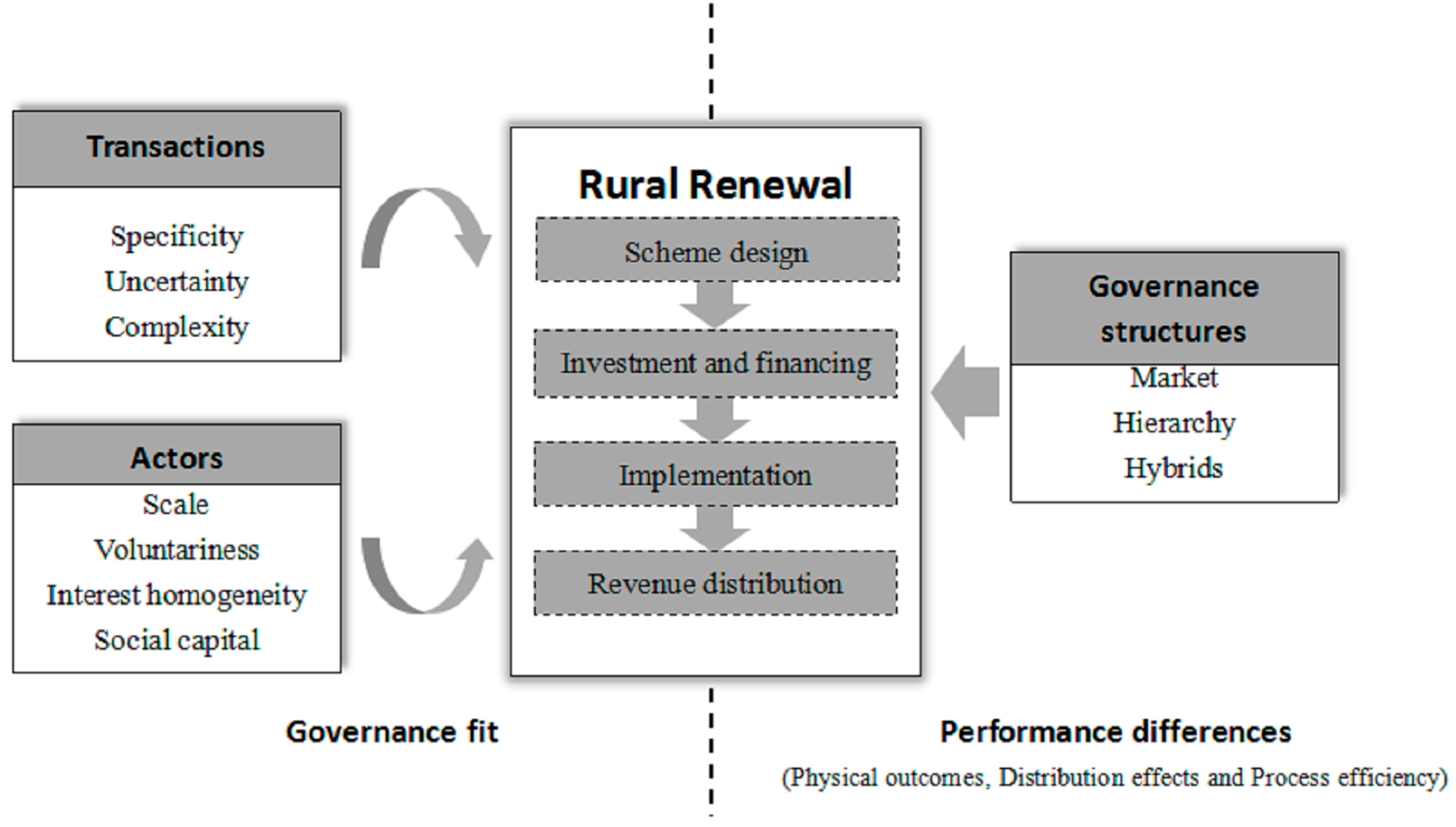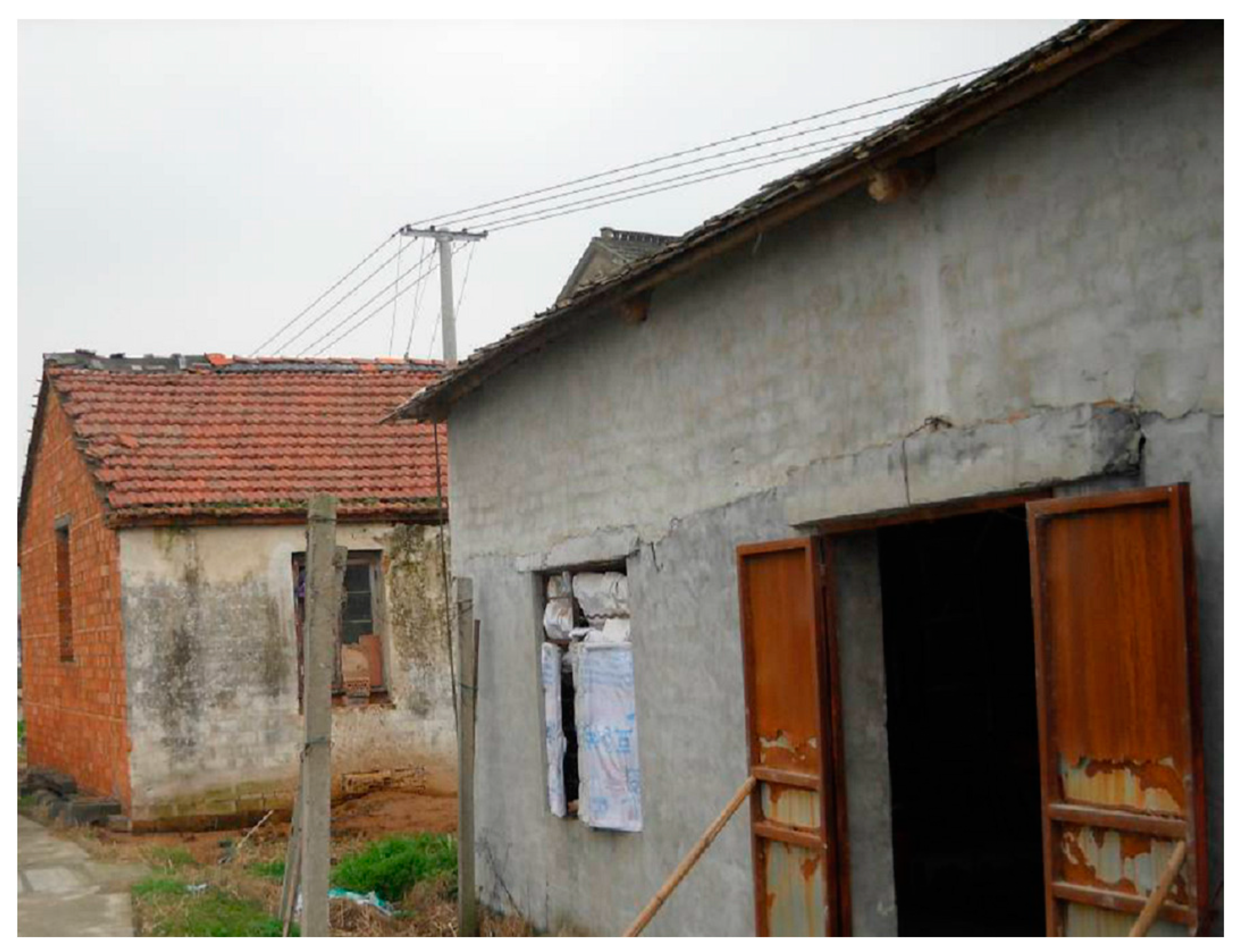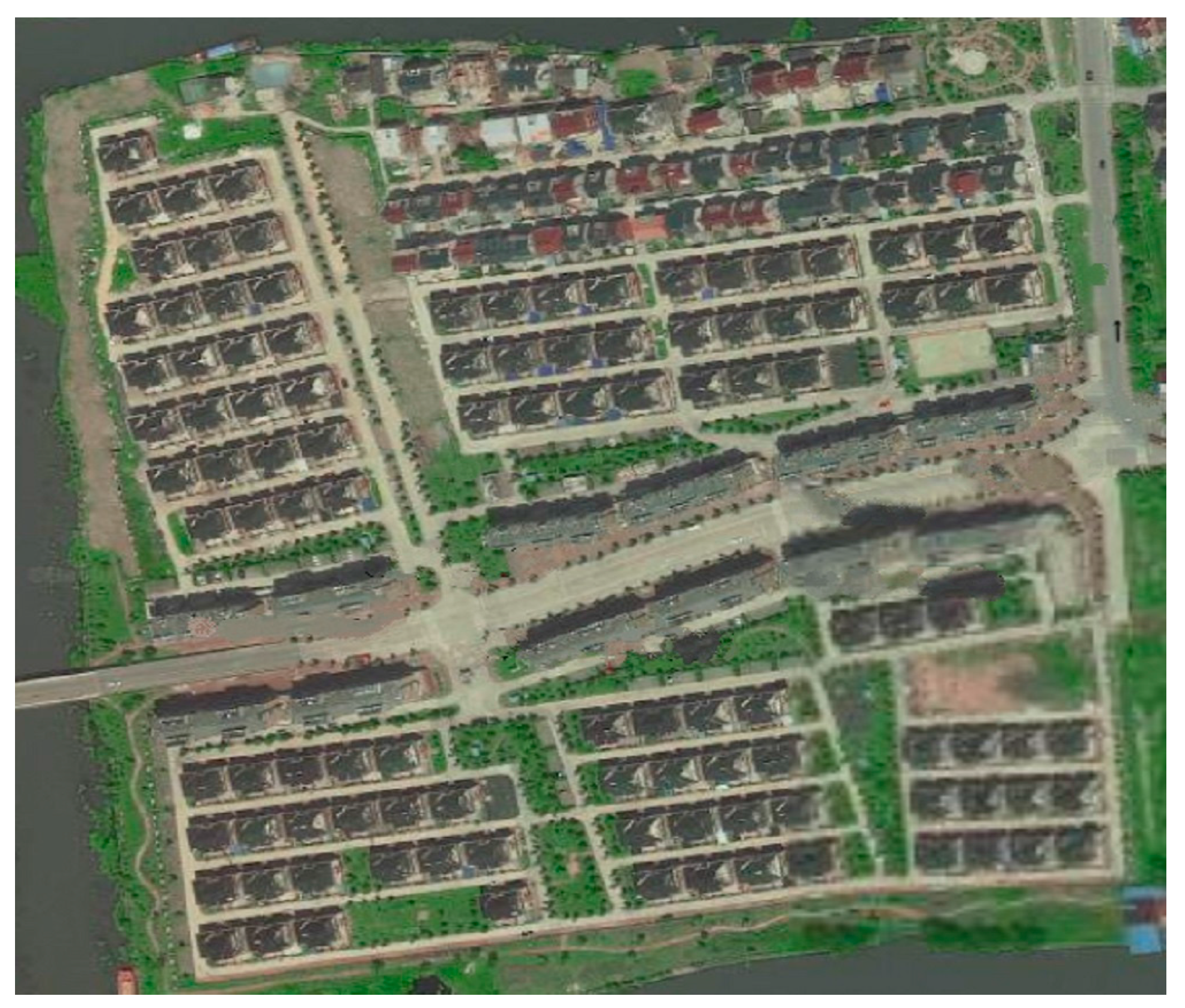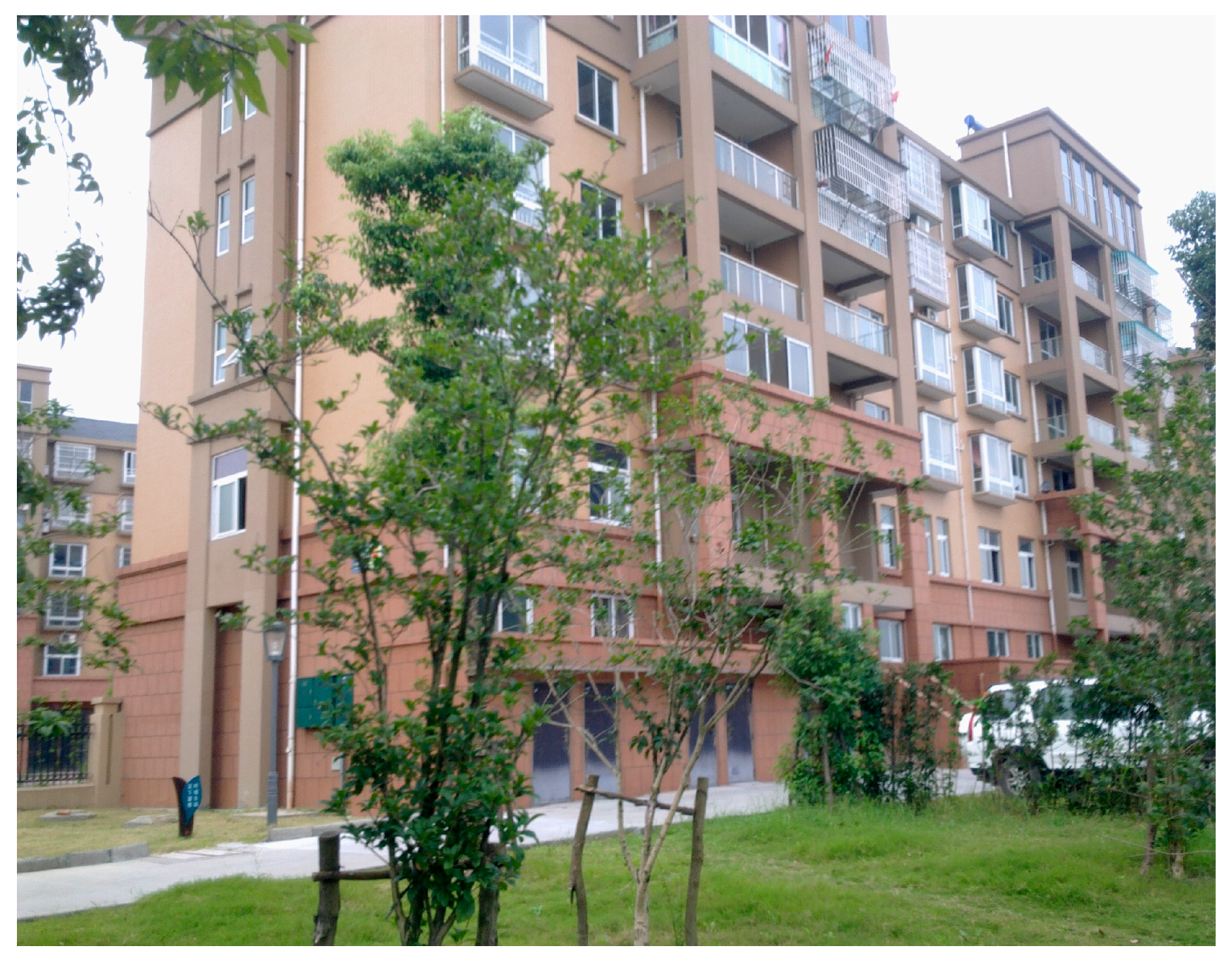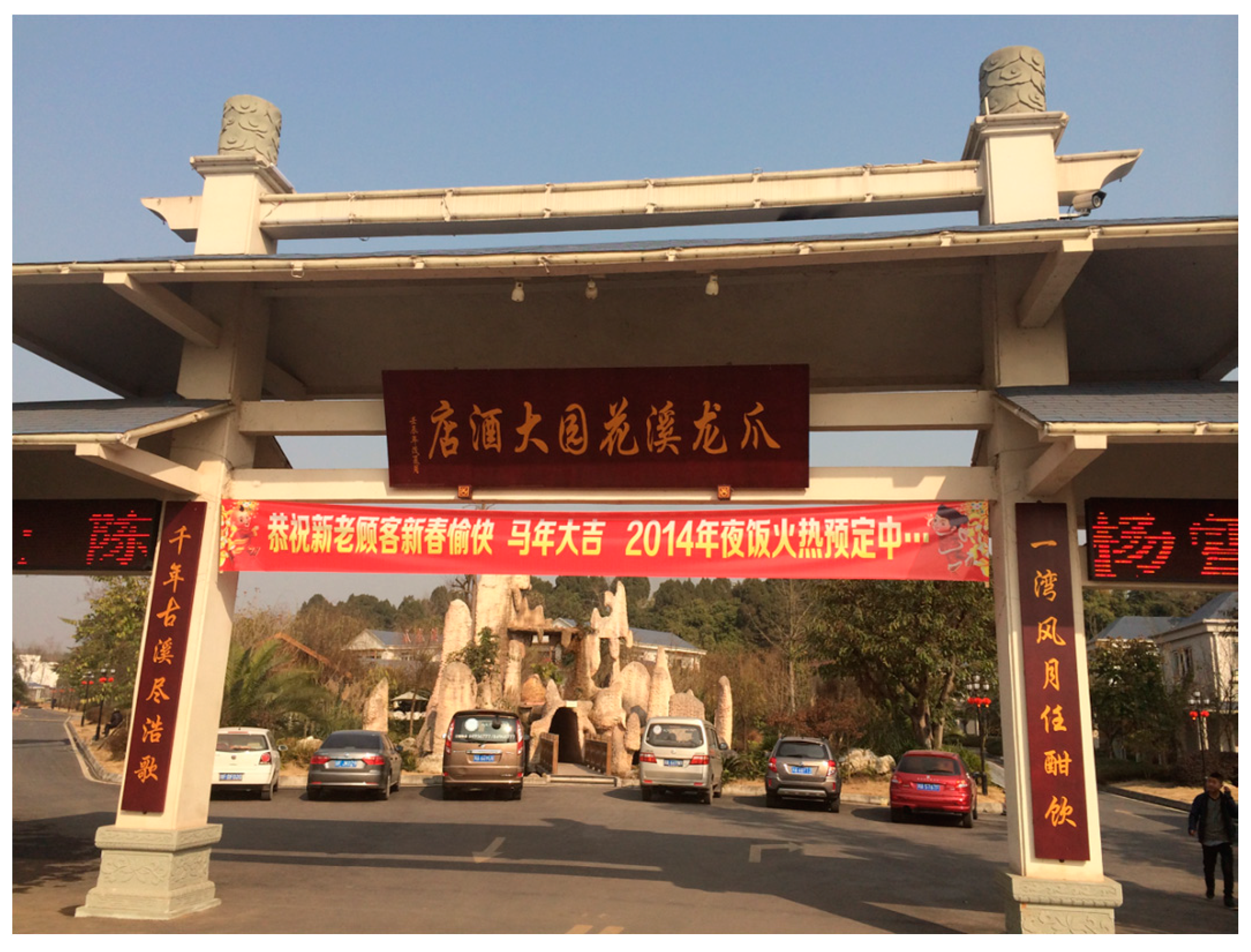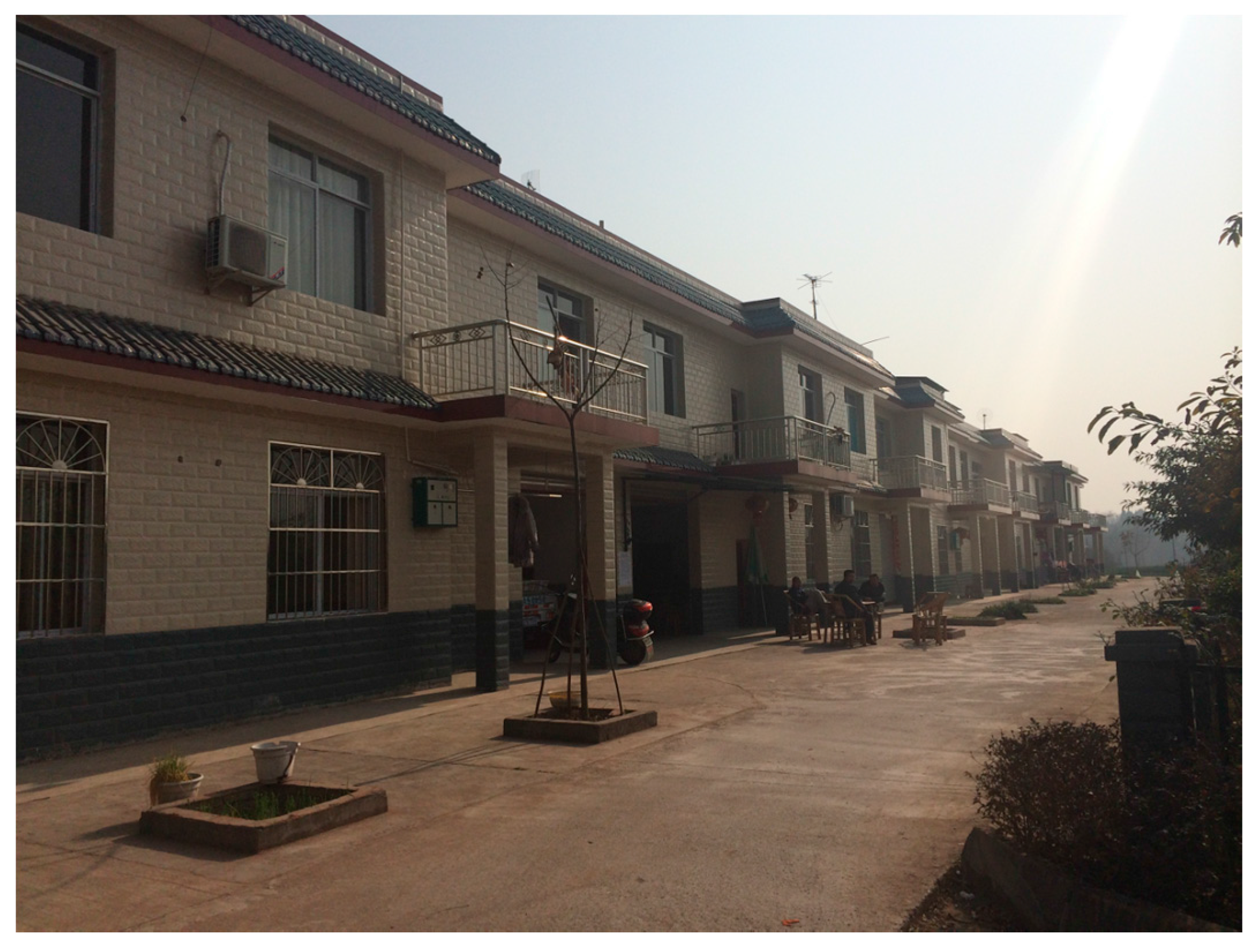1. Introduction
China has experienced rapid economic development for over 30 years, which has accelerated the improvement of rural and urban areas. However, these improvements are imbalanced. A significant gap is observed between rural and urban areas in their physical conditions, such as their living conditions and residential environments. In rural areas, the land use structure for production, living and ecology is not sufficiently rational and the land use pattern is far too extensive. And the rural residential environment is obsolete, badly planned and poor [
1]. Moreover, the social wealth gap between rural and urban areas is still large. In 2011, the income gap between urban and rural areas was 3.13:1 [
2]. Therefore, the Chinese government put forward the national policy so called “Rural-urban integrated development” to bridge the development gaps between rural and urban areas [
3,
4,
5,
6]. In particular, living quality of rural areas should be improved to realize the equity on physical conditions in rural-urban areas; and income and vitality of rural areas should be increased and enhanced respectively to narrow the social wealth gap in rural-urban areas. To facilitate rural-urban integrated development, the Chinese government has promoted a strategy of rural renewal to construct a new countryside with the characteristics of developed production, affluent living conditions, civilized local customs, a clean and tidy village appearance and democratic administration [
3,
4,
5,
6]. Recently, the Chinese government further announced to accelerate rural revitalization [
7]. At present, rural renewal has been implemented nationwide for many years.
In fact, rural renewal is not a phenomenon unique to China. The Rural Development Policy (2014–2020) of the European Union proposed improvements to resource efficiency and the viability and competitiveness of all types of agriculture; improvements to the ecosystems related to agriculture and forestry; improvements to the social inclusion, poverty reduction and economic development [
8]. However, this paper focuses on rural renewal as it pertains to activities related to consolidating land, improving living conditions and boosting the economy to promote new countryside construction and rural revitalization in the Chinese context of rural-urban integration.
In general, two modes of rural renewal have primarily been observed in contemporary China. The first mode is government-led rural renewal. As the investor and organizer, the government is actively involved in the entire process of rural renewal. For instance, local governments can manipulate redevelopment of villages within the city, namely, urban village renewal [
9], or finance and enforce hollowed village revitalization and land consolidation projects to optimize the rural land use structure and residential environment to meet the requirements from the central government [
10,
11]. The second mode is self-organized rural renewal. Led by the village committee and elites, farmers organize themselves to implement rural renewal and boost rural development by taking advantage of the local natural, economic and social resources. For example, many villages in the Pearl River Delta region have experienced industrialization and urbanization launched by village collectives and village leaders [
12]. In addition, without government intervention, farmers in certain regions still drive rural land consolidation and rural construction land transfers to promote village development [
13,
14].
Rural renewal in China has already attracted the attention of many researchers and a substantial body of literature is concentrated on urban village renewal. The literature explains the power relations and urban coalitions among stakeholders as well as the distribution of incremental land revenue during urban village renewal [
15,
16]. In addition, the literature analyzes the multiple effects urban village renewal has exerted on urban development, such as ameliorating the physical environment of the city and improving living conditions but failing to completely eliminate the phenomenon of urban villages [
17,
18]. And studies have also focused on the more general object of villages located at the urban fringe and in remote areas of China. The literature discusses the diverse functions of hollowed village revitalization and land consolidation, such as promoting agricultural production, upgrading living conditions in rural areas and protecting the environment [
19,
20] and a comprehensive index system has been established to evaluate the performances of new countryside construction in several regions of China as a reflection of performance diversity [
21].
However, to the best of our knowledge, few studies have explored the reasons underlying the occurrence of different rural renewal modes. Moreover, although studies have focused on the performance of rural renewal, the performance was not assessed from the perspective of rural-urban integration or at the level of governance structure (i.e., rural renewal modes). Hence, our research intends to answer the following questions. First, why have different modes of rural renewal emerged in China? Second, what are the performance differences of the rural renewal modes in the context of rural-urban integration? Evidently, conducting this type of research is of great importance for optimizing rural renewal governance to optimize its key role in fulfilling rural-urban integration in contemporary China. To that end, we will study rural renewal in China through two typical cases based on an Institution of Sustainability (IoS) framework.
More specifically, we attempt to identify the determinants of selection between government-led and self-organized modes to reveal the logic of governance fit. However, we also wish to elucidate the performance of government-led and self-organized rural renewal from the perspectives of physical outcomes, distribution effects and process efficiency. In other words, we mainly concentrate on the directly observed land use change and socio-economic performance of rural renewal. However, the indirect or hidden outcomes, such as ecological issues generated by rural renewal, external actors influenced by rural renewal and other mechanisms interconnected with rural renewal, are not considered because these processes and outcomes occur gradually and are too complicated to identify [
22,
23], particularly for a single paper with a finite scale and limited evidence.
The paper is organized as follows. The second section modifies the IoS framework and applies it to understanding rural renewal in China, namely, analyzing the governance fit and performance differences in theory. The third section introduces the research methodology, including the methods for case selection, survey and comparison analysis. The fourth section displays the main process and outcomes of rural renewal in China through two typical cases. The fifth section presents the comparative analysis between the two cases based on the theoretical framework. The last section provides our conclusions and recommendations.
3. Research Methods
The case study and comparative analysis methods are applied in this research. First, we narrate each case in detail, including the entire rural renewal process, the actors’ characteristics and their actions, costs and revenue distributions. Second, we illustrate the determinants of governance fit by comparative analysis. Third, given the context of rural-urban integration, we elaborate the performance differences, such as physical outcomes, distribution effects and process efficiency, of each rural renewal mode.
3.1. Case selection and Survey Method
As mentioned above, rural renewal in China can be categorized into two main types: government-led or self-organized rural renewal. We select two cases, one in each category, according to the criteria for typical case selection along with expert advice and our own experience [
38]. The two cases are rural land consolidation of H Village in Jiashan County, Zhejiang Province and rural construction land transfer and tourism development of S Village in Jintang County, Sichuan Province.
We conducted the fieldwork in Jiashan County, Zhejiang Province and in Jintang County, Sichuan Province from 2012 to 2014. During the fieldwork, county-level officials governing rural renewal introduced relevant rules and provided general information about the projects in their counties. These officials also recommended the cases for further study. Subsequently, we started to conduct the semi-structured interviews in H Village and S Village. To select interviewees, we adopted the stakeholder-based approach [
39] and interviewed village leaders, village elites, township-level officials and farmers involved in or affected by rural renewal. We particularly focused on the scheme design, investment and financing, implementation and revenue distribution stages as well as the interviewees’ attitudes and comments on rural renewal. The interviews among different actors also served to cross-check information. All the information provides the basis for further case studies and comparative analyses.
3.2. Comparative Analysis Method
The comparative analysis of our research consists of three steps according to the IoS framework. Initially, we distinguish the properties of transactions and the characteristics of actors and then make two tables. One table displays the level of specificity, uncertainty and complexity regarding each transaction and another displays the scale of the actors as well as the extent of voluntariness, interest homogeneity and social capital.
Next, we analyze the features of governance structures and assess their performance. We concentrate on the performance of governance structures in the cases, including (1) whether they achieved equity among physical conditions, such as planning appropriate rural residential areas and providing sufficient infrastructure for production and living; (2) whether they narrowed the social wealth gap between rural and urban areas, such as releasing the potential value of rural land and then allowing farmers and rural areas to share greater land revenue and accumulate sufficient funds and capital for sustainable development; and (3) whether they drove rural-urban integrated development in a high process efficiency manner, such as by reducing the transaction costs for information, decisions, negotiations, coordination and monitoring. Thus, the other table was created to present our findings.
Finally, we reveal the impacts that diverse properties of transactions and characteristics of actors have on the selection of governance structures and compare the performance of different rural renewal modes via two cases analyses. Thus, according to the table summarizing all the above findings, we explain the logic of governance fit and present the performance differences of rural renewal with regard to rural-urban integration. As such, the research questions can be simultaneously addressed.
5. Comparison between the Two Cases
In general, the governance fit of rural renewal in H Village and S Village varied for different reasons and contributed to different performances.
5.1. Transaction Properties
The scheme design of H Village renewal was more complicated than that of S Village (
Table 2) because the scale of H Village renewal was larger, with the project area encompassing 199.37 mu, whereas the scale of S Village renewal encompassed only 33.26 mu. The larger scale of rural renewal meant that more types of interest, e.g., economic, social and ecological relations, had to be considered and coordinated, which added to the complexity of the scheme design. Additionally, the limited cognitive capability of designers in both cases led to a high level of uncertainty (I) regarding the scheme design because the appropriateness or the feasibility of the scheme in this stage was difficult to determine (
Table 2).
In the stage of investment and financing, the level of asset specificity in S Village was higher than that in H Village (
Table 2). The total cost of H Village and S Village were approximately 59.04 million yuan and 31.18 million yuan, respectively. Intuitively, the cost of H Village renewal was slightly more than that of S Village, indicating that the asset specificity of H Village renewal was slightly stronger. However, the investment of H Village renewal was not a heavy financial burden for the local government because Jiashan County, which is in the developed eastern part of China, reported a GDP totaling 32.14 billion yuan in 2011 (Adopted from
http://www.tjcn.org/tjgb/11zj/23592.html) and the public finance income for the county-level government, which was the investor of H Village renewal, was more than 2.43 billion yuan (Adopted from
http://www.tjcn.org/tjgb/11zj/23592.html). In contrast, Jintang County, in the less developed western part of China where S Village is situated, reported a GDP (Refer to
http://www.tjcn.org/tjgb/23sc/24575.html for details.) that was only half as high as the GDP reported by Jiashan County in 2011 and the investor of S Village renewal was a private enterprise founded by Wu; thus, the capital capability of the investor in S Village was much weaker than that in H Village. In other words, compared with the government in a developed region, if a private enterprise in a less developed region is required to invest a substantial amount of money into rural renewal, it would not be able to afford other types of investment, which heightened the level of asset specificity.
During the implementation stage, the land asset specificity of H Village renewal was stronger than that of S Village (
Table 2). The scale of H Village renewal was much larger, suggesting that more land had to be acquired. As the acquisition of land increased, the investor had to rely more heavily on land with a specific location (i.e., lock-in effect); thus, these transactions were more likely to be the victim of opportunistic behavior. Put another way, if a land owner decided to hold out on transferring, then the investor who had acquired a large amount of land would suffer from project suspension because of a lack of necessary land. Such a scenario reflects the high level of specificity and its hazards. Additionally, both H Village and S Village faced a rather high level of uncertainty (II) (
Table 2), such as the probability that rural renewal would be implemented in accordance with the scheme and the probability of conflicts during implementation. In the stage of revenue distribution, both cases were also confronted with a high level of uncertainty (II) (
Table 2). Certain unanticipated issues occurred, such as the probability of further conflicts incurred by distribution.
5.2. Characteristics of the Actors Involved
First, fewer actors were involved in the S Village renewal than in the H Village renewal (
Table 3). Only 37 households participated in the rural renewal in S Village, whereas 279 households participated in the rural renewal of H Village. Second, the extent of the actors’ voluntariness in S Village was stronger than that in H Village (
Table 3). Specifically, in S Village, the rural renewal was initiated by the village elite and obtained profound support from the farmers and the farmers had the right to decide whether to participate in the project based on their own willingness. However, in H Village, the project was initiated and supported by the local government with coercive administrative commands. The government established the leading group and working group to drive the project and the government constructed and approved the scheme of rural renewal, regardless of the farmers’ opinions. The rights of farmers were restricted and farmers became solely passive participants.
Third, the extent of homogeneous interest among the actors was stronger in S Village than that in H Village and more social capital was accumulated in S Village as well (
Table 3). As a model village of farmer autonomy, the collective coordination mechanism of S Village was conducive to mitigating the diverging interest among actors [
42,
43]. Furthermore, all farmers participating in the project had been neighbors for many years. They were familiar with each other and experienced frequent interactions, including daily communication, work cooperation, etc.; thus, we can infer that trust and strong social ties formed among the farmers. Therefore, a considerable amount of social capital had been accumulated to generate cooperation and reciprocity. However, many farmers in H Village had migrated to urban areas and interacted less with each other than before, which led to different interests among actors and weakened social network of the traditional rural community [
44]. Consequently, the social capital in H village was gradually eroded.
5.3. Cost and Competence of Governance Structures
In the case of H Village, the local government established the leading group and working group at the township level and village level and it relied on top-down administrative commands to coordinate the entire process of rural renewal, including relocation, compensation and new residence construction. Led by the local government, the performance of H Village renewal was remarkable in improving the physical conditions (
Table 4). Farmers moved out of their old houses, which presented poor living conditions and moved into new houses in the new residential area. The new residential area for farmers consisted of modern apartments with well-designed layouts, a scenic environment and well-equipped infrastructure (
Figure 3 and
Figure 4). Obviously, it achieved the equity of rural-urban physical living quality to a great extent.
In addition, the local government controlled the revenue distribution. The government had the power to devise the standard for compensating the relocated farmers and directly distribute the land revenue induced by rural renewal, its investment in rural renewal (approximately 59 million yuan) was covered and net revenue was gained based on the direct income earned by utilizing the LUTRG quotas from the project to lease land to secondary and tertiary industries as well as by obtaining payments for new residences from farmers. In the long term, this pattern would accelerate the local economic development by exploiting LUTRG quotas to attract investments from enterprises and promote industrialization and urbanization. As a result, the local government even gained long-term revenue from the rural renewal in the form of taxes (
Table 4).
However, farmers temporarily attained only limited social wealth induced by the rural renewal in the form of compensation and new residences. In addition, the traditional production system of livestock breeding had to be given up after farmers moved into the apartments because of the inadequate space and a number of farmers failed to find a new method of earning a living. Thus, the rural renewal in H Village even exerted a negative impact on farmers’ livelihood to some extent. Overall, the government-led rural renewal in H Village transferred the social wealth to the rural area only once and in an unsustainable way and its performance regarding the facilitation of rural development did not meet the requirements of rural-urban integration (
Table 4).
Nevertheless, the government limited the farmers’ opportunity sets by applying coercive public power to prevent the actors from displaying opportunistic behavior, such as holding out. Therefore, the project span of the H Village renewal with a large scale and heavy workload was nearly equivalent to that of the S Village renewal with a small scale and light workload. In addition, under the strict supervision of the government, the scheme of H Village renewal was implemented bindingly and conflicts never occurred, although it presented issues related to incomplete information and the bounded rationality of decision makers at the upper levels. For instance, the new residential area was far from the agricultural area, which made it inconvenient for farmers to perform daily work and some farmers could not acclimate to the new way of life. Many farmers complained about these issues in their interviews. The above issues suggest that government-led rural renewal may induce ex-post transaction costs, such as decision deficiencies and may exaggerate the process efficiency loss (
Table 4).
The self-organized rural renewal in S Village was distinguished by the following features: it was led by the village committee and village elite, it included farmer coordination and it provided for revenue sharing. Under the leadership of the village committee and village elite, local farmers organized themselves to change the extensive and scattered form of their previous living environment into an intensive and consolidated form and to utilize the land they saved to develop rural tourism by constructing a village hotel. The village elite took responsibility for providing roads, water pumps, electricity lines, green space and other infrastructure. In S Village, farmers now live in the new residential area instead of the old houses with inferior living conditions or damaged houses affected by the earthquake. The newly constructed residential area includes well-equipped townhouses with a well-organized layout and neat environment, thereby attaining the goal of upgrading the rural physical conditions (
Figure 6 and
Figure 7 and
Table 4).
The rural renewal in S Village was intriguing because of the revenue sharing distribution (
Table 4). The farmers attending the project obtained all the land transfer income (average 180,000 yuan per mu), which was much higher than the land acquisition compensation standard (average 17,400 yuan per mu). The village elite as the land user spent 1 million yuan on providing the infrastructure for the new residential area; therefore, self-organization enabled the farmers to receive the highest direct revenue from rural renewal. In addition, S Village benefited from interest in rural tourism and the appropriate development strategy was able to reduce the side effects on farmers’ livelihood caused by rural renewal that changes the traditional method of earning a living by providing approximately 120 jobs for farmers (the population of S Village is only 304). Moreover, this development strategy also attracted more people from the urban area to the rural area for vacations and then generated consumption revenue for the rural area. As such, the rural renewal in S Village positively shifted social wealth from the urban area to the rural area and it increased the farmers’ income and transformed the rural industrial structure.
Additionally, the coordination mechanism nested in self-organization helped enhance the process efficiency of rural renewal (
Table 4). In S Village, the farmers communicated their requirements for relocation compensation and resettlement and opinions on the plan for the new residential area and then balanced their diverse interests as well as restrained their self-interested motivations to fulfill the collective action through coordination. Consequently, the farmers were willing to pool their land property to form a bundled price and negotiate with the land user collectively. In addition, the farmers’ living conventions and preferences for single houses were considered during the scheme design; therefore, townhouses rather than apartments were built in the new residential area. Thus, the effective coordination mechanism facilitated information communication and relieved potential conflicts of interest to form a fully considered, suitable and feasible strategy of rural renewal. Therefore, the process efficiency loss caused by decision deficiencies and opportunistic behavior was avoided. Moreover, issues such as hold-out problems at the implementation stage, additional compensation requirements after signing the land transfer contract and negative comments on the revenue distribution from farmers were not observed.
5.4. Summary
The two cases presented above demonstrate that the properties of transactions and characteristics of actors were the determinants of governance fit. Further, the performance of the government-led mode in H Village was undoubtedly distinct from that of the self-organized mode in S Village (
Table 5).
The level of specificity in the implementation stage in H Village renewal was higher than that in S Village and H Village also faced a high level of uncertainty (II) in the stages of implementation and revenue distribution. The government-led mode controlled the span of bargaining among stakeholders and the occurrence of opportunistic behavior to complete the large scale of new countryside construction in a short time. In addition, no conflicts occurred during the rural renewal; therefore, it properly fit the governance demand for high-powered control under the high levels of specificity and uncertainty (II). The government-led rural renewal in H Village fully reflected the advantages of hierarchy by forcing actors to comprise and coordinate by strengthening control, weakening incentives and managing or even preventing potential conflicts to improve the process efficiency.
Additionally, although the level of specificity in the stage of investment and financing in S Village renewal was higher than that in H Village and the levels of uncertainty (II) in the stages of implementation and revenue distribution were as high as in H Village, the nested coordination mechanism of the self-organized mode played a critical role in behavior control, thereby ensuring no hold outs and no extra interest requirements throughout the rural renewal. Moreover, self-organization was also able to weaken the incentives associated with opportunistic behavior and restrain the negative influence from uncertainty (II), thereby providing stakeholders with safeguards by relying on another type of high-powered control.
As for the distribution effects, the local government manipulated the entire H Village renewal process, including revenue distribution and it attained the distribution advantage in both the short term and long term via land leasing and taxes. However, the farmers and rural area received limited benefits. Furthermore, in H Village, ex-post costs of decision deficiencies occurred, suggesting that process efficiency was higher in the former period but subsequently decreased. Because of the bounded rationality of central decision makers and asymmetric information among layers, the top-down administrative command mechanism that hierarchy relies on is not able to align with the high complexity and uncertainty (I) of the scheme design.
Given the governance demand generated by the complexity and uncertainty (I) of rural renewal, self-organization was selected in S Village. The farmers together designed the scheme of rural renewal that was suitable for the local conditions by utilizing local knowledge and they also managed the complicated interest relations, such as the land transfer price and the new residence plan, via a coordination mechanism from the very beginning. Thus, the newly built residences lived up to the expectations of the farmers; the blueprint of rural tourism fit the local conditions; and the obstacles to project implementation, such as conflicts, were avoided. All these phenomena reflect the advantages of decentralized governance structures. Therefore, by reducing the information costs, avoiding decision failures and controlling the complexity and uncertainty (I) of the scheme design, the physical outcomes and process efficiency of rural renewal were improved.
Admittedly, self-organization cannot be realized without favorable characteristics among the actors. Compared with the actors of the H Village renewal, the scale of the actors was smaller in the S Village renewal, the extent of their voluntariness and interest homogeneity was stronger and social capital had accumulated to a greater extent. As a consequence, no ex-ante long-term bargaining occurred and the coordination cost of collective action was saved because of the small scale. Moreover, the small scale also allowed every actor to share a comparatively large proportion of private revenue, with most households earning more than 100,000 yuan from the land transfer, which exceeded the cost of building new houses. Obviously, the private revenue was attractive enough to provide the incentive for collective action. In addition, extra costs of enforcement were not incurred because of the high extent of voluntariness. Last but not least, the small scale was beneficial for monitoring and regulating and the social capital, such as the convention of reciprocity stemming from the long-standing practice of farmer autonomy, provided the informal rules for rural renewal, thereby illustrating one of the reasons why there were no hold outs or other conflicts of interest. Briefly, the characteristics of actors in the S Village renewal helped foster collective action to settle issues related to the initial supply of self-organization.
As for revenue distribution, farmers in S Village gained the most from the rural renewal and the rural renewal in S Village also continuously shifted the social wealth to the rural area because the operation of the village hotel and the development of rural tourism created off-farm income. All these factors contributed to narrowing the social wealth gap and facilitating rural development.
6. Conclusions
In the context of rural-urban integration, this study reveals the logic underlying the fit of governance with regard to rural renewal in contemporary China and illustrates the performance differences from the perspectives of physical outcomes, distribution effects and process efficiency. An IoS framework is developed and a detailed comparison between two typical cases is performed. The results indicate that (1) the properties of transactions and characteristics of actors mutually lead to the different governance structures (i.e., government-led mode and self-organized mode); (2) different governance structures result in different rural renewal performance. Two specific conclusions are listed below.
First, large scale of rural renewal induces high levels of specificity and unanticipated probability of various outcomes results in uncertainty (II). Given high levels of specificity and uncertainty (II), governance structures with higher-powered control, such as the government-led mode, are required to implement rural renewal and reduce transaction costs. However, because of the hierarchical mode, the actor leading the entire process of rural renewal, such as the local government, obtains the distribution advantages and the rural-urban social wealth gap is not significantly narrowed. Moreover, hierarchy may induce process efficiency losses. The rural renewal in S Village showed that the self-organized mode was also able to weaken the incentives for opportunistic behavior and strengthen the action control, thereby fitting the specificity and uncertainty (II) of the transaction and indicating that hierarchy was not the sole option.
Second, large scale of rural renewal leads to high level of complexity, while human being’s cognitive limitations cause uncertainty (I). Given high levels of complexity and uncertainty (I) demand governance structures with decentralized features, such as the self-organized mode, to implement rural renewal in manner that reduces transaction costs. The indispensable preconditions for the supply of self-organization are the small scale of the actors, the large extent of voluntariness and interest homogeneity and abundant social capital. In addition, self-organization can effectively narrow the rural-urban social wealth gap.
Based on our research conclusions above, the policy recommendations are as follows. First, a “one-size-fits-all” mode for governing rural renewal is not available. The governance structure of rural renewal should be aligned with context-specific conditions, which are properties of the transactions and characteristics of the actors. Second, in terms of government-led rural renewal, introducing public participation and negotiation should be attempted because the mechanisms can fully exploit the dispersed local knowledge to ensure that the physical outcomes of rural renewal better meet the local demands and guarantee a more reasonable interest distribution. Third, farmers and villages with appropriate conditions should be encouraged to conduct rural renewal in a self-organized way and identify development paths that are suitable for local conditions, with the goal of gradually changing the method of social wealth transfer and providing a reliable and sustainable basis for rural-urban integration.
Admittedly, the empirical evidence from the two cases may be not sufficient to fully illuminate the governance fit and the performance difference of rural renewal. Moreover, we have not further clarified the ecological, external and interconnected outcomes of rural renewal, and have not yet investigated the impacts of landscape factor [
20,
45]. However, the research provides a number of insights: first, it provided abundant information on rural renewal in contemporary China and could be used as the basis for further studies; second, it combined the IoS framework with Williamson’s TCE paradigm, thereby extending the extant research pattern while also providing new theoretical insights for understanding rural renewal; and third, it comprehensively explored the factors affecting governance fit and revealed the effects of the governance structure on the process efficiency and physical and distributional outcomes. All the aforementioned achievements may fill the research gap of relevant topics to some degree. Furthermore, subsequent research can be devoted to the determinants of rural renewal mode selection to provide more empirical evidence on the logic of governance fit. In addition, researchers can focus on both the direct and indirect (or hidden) performance of rural renewal from a broader perspective and propose more comprehensive recommendations for governance innovation.
